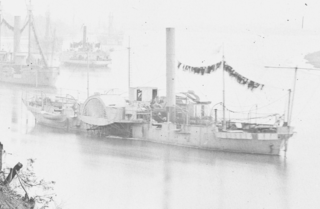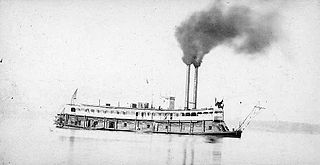The first USS Arizona was an iron-hulled, side-wheel merchant steamship. Seized by the Confederate States of America in 1862 during the American Civil War, she was captured later the same year by the United States Navy.

USS Hartford, a sloop-of-war, steamer, was the first ship of the United States Navy named for Hartford, the capital of Connecticut. Hartford served in several prominent campaigns in the American Civil War as the flagship of David G. Farragut, most notably the Battle of Mobile Bay in 1864. She survived until 1956, when she sank awaiting restoration at Norfolk, Virginia.

The first USS Miami was a side-wheel steamer, double-ender gunboat in the United States Navy during the American Civil War.

CSSSelma was a steamship in the Confederate States Navy during the American Civil War. She served in the Confederate Navy first as Florida, and later as Selma. She was captured by the Union Navy steamer USS Metacomet during the Battle of Mobile Bay. She served as USS Selma until the end of the war, when she was decommissioned and sold for use as a merchant ship.

USS Albatross was a screw steamer rigged as a three-masted schooner acquired by the Union Navy during the beginning of the American Civil War. She was outfitted as a gunboat with heavy guns and used in the Union blockade of the waterways of the Confederate States of America.
USS Curlew was a Union Navy stern-wheel steamer that saw service during the American Civil War. Built in 1862 in Pennsylvania as a civilian vessel, she was purchased by the Union Navy on December 17, 1862. Converted into a tinclad gunboat, she saw service from 1863 to 1865, often serving on the Mississippi River, the Ohio River, and the Tennessee River. In May 1863, she was involved in a minor action against Confederate forces on the Mississippi River off of the shore of Arkansas. July saw Curlew take part in an expedition up the Red River of the South, the Tensas River, the Black River, and the Ouachita River that captured two steamers and destroyed two more and a sawmill. On May 24, 1864, she dueled with Pratt's Texas Battery while on the Mississippi River, and on November 4 of that same year, was near the action of the Battle of Johnsonville but was unable to join the fighting. Decommissioned on June 5, 1865, she was sold in mid-August and her further career is unknown.

USS Winona was a Unadilla-class gunboat built for service with the Union Navy during the American Civil War. Winona was heavily armed, with large guns for duels at sea, and 24-pounder howitzers for shore bombardment. Winona saw significant action in the Gulf of Mexico and in the waterways of the Mississippi River and was fortunate to return home safely after the war for decommissioning.
USS Meteor was a gunboat acquired by the Union Navy during the American Civil War. She carried heavy artillery and became part of the sea blockade of waterways of the breakaway Confederate States of America.

USS Octorara was a steamer acquired by the Union Navy during the American Civil War. She was used by the Navy to patrol navigable waterways of the Confederacy to prevent the Confederates from trading with other countries.

USS Fort Hindman was a steamer acquired by the Union Navy during the American Civil War. She was placed in service and used by the Navy to patrol navigable waterways of the Confederacy to prevent the South from trading with other countries.
USS Cowslip was a steamer acquired by the Union Navy during the American Civil War.
The first USS Mist was a steamer purchased by the Union Navy during the American Civil War. She was planned by the Union Navy for use as a gunboat stationed off Confederate waterways to prevent their trading with foreign countries.
USS Springfield was a steamship purchased by the Union Navy during the American Civil War. She was used by the Union Navy as a gunboat assigned to patrol Confederate waterways.
USS Brilliant was a steamer purchased by the Union Navy during the American Civil War. She was used by the Union Navy as a gunboat assigned to patrol Confederate waterways.
The first USS Silver Cloud was a steamer acquired by the Union Navy during the American Civil War.

USS Nymph was a steamer acquired by the Union Navy during the American Civil War. She was used by the Union Navy as a dispatch boat in support of the Union Navy blockade of Confederate waterways.
USS Pink was a steamer commissioned by the Union Navy during the American Civil War. She served the Union Navy's struggle against the Confederate States of America in various ways: as a tugboat, a gunboat, and as a small transport.
USS Tritonia was a 202-ton steamer commissioned by the Union Navy during the American Civil War.
USS Stockdale was a steamer commissioned by the Union Navy during the American Civil War.
USS Siren was the 214-ton wooden-hulled, stern-wheel steamer White Rose launched in 1862 that the Union Navy purchased in 1864. The Navy outfitted Siren with two 24-pounder howitzers for use in bombardment and assigned her to operations on the Mississippi River where Union forces were attempting to maintain control of the river in order to split the Confederate States of America in two. The Navy sold her in 1865 and new owners returned her name to White Rose. They abandoned her in 1867.








